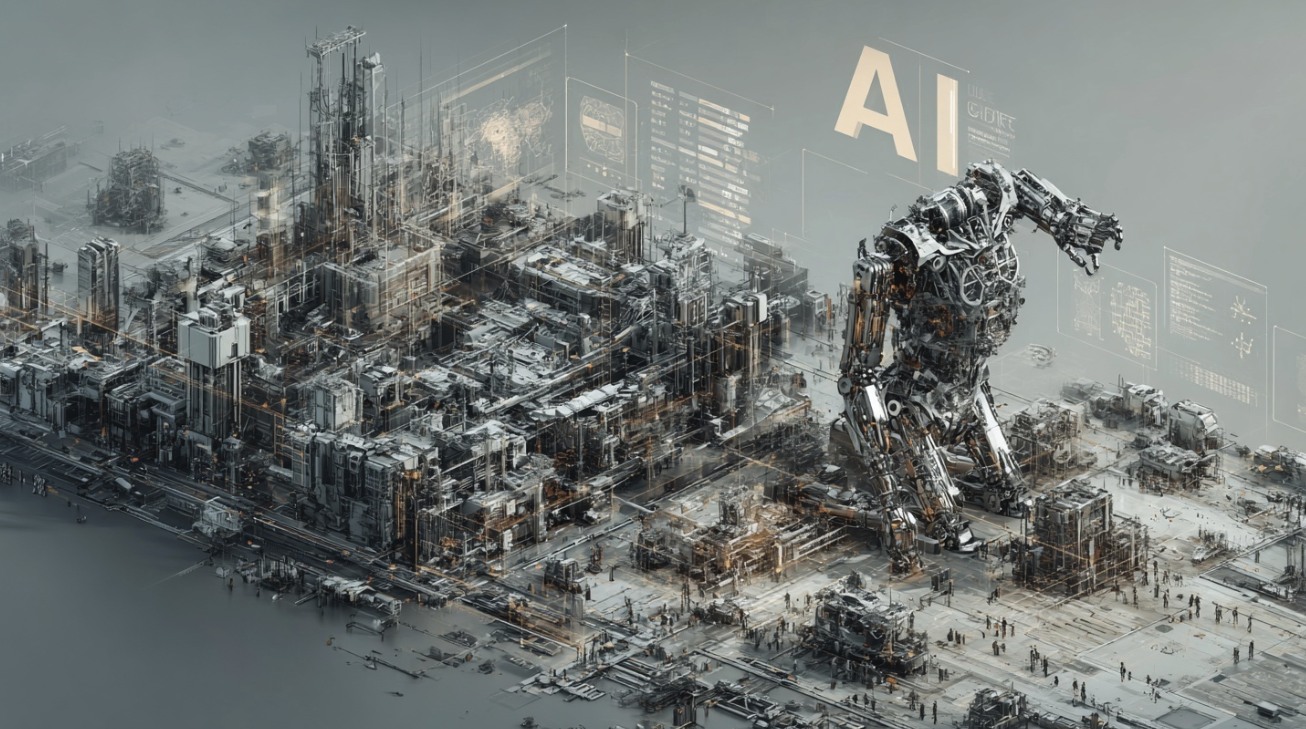🌟 AI Industry Daily Digest

9/24/2025 | Insights into AI's Future, Capturing Tech's Pulse
🔥 Today's Headlines (2–3)
Most influential breakthroughs, diversified sources
📰 OpenAI is building five new Stargate data centers with Oracle and SoftBank
Key Insight: OpenAI is making a massive infrastructure play to support its future AI models, signaling a significant shift in its operational strategy and reliance on cloud giants.
OpenAI is reportedly in talks to build five new "Stargate" data centers, a project that would represent a massive expansion of its computing power. Partnering with Oracle and SoftBank, the initiative aims to equip OpenAI with the necessary infrastructure to train and deploy increasingly large and complex AI models. This move highlights the immense computational demands of cutting-edge AI and OpenAI's strategy to secure dedicated resources.
👉 Read More...
Source: TechCrunch
📰 Deutsche Bank delivers AI-powered financial research with DB Lumina
Key Insight: Major financial institutions are integrating AI into core research functions, demonstrating a practical application of LLMs for enhanced analytical capabilities and client services.
Deutsche Bank has launched DB Lumina, an AI-powered platform designed to deliver financial research. This initiative leverages AI to process vast amounts of financial data, identify trends, and generate insights, aiming to provide clients with more timely and sophisticated analysis. The platform's development signifies a broader trend of financial services adopting AI to improve efficiency and competitive edge.
👉 Read More...
Source: Google Cloud Blog
⚡ Quick Updates (8–10)
Rapid grasp of industry dynamics; interleave sources
- 🎯 Introducing the DORA AI Capabilities Model: 7 keys to succeeding in AI-assisted software development – A new framework from Google Cloud outlines essential elements for effective AI integration in software engineering workflows. (Source: Google Cloud Blog)
Read More... - 🚀 SenseTime Healthcare Showcases AI-Powered Pathology Solution at Suzhou Academic Conference – SenseTime is advancing AI in medical diagnostics with a new pathology solution, indicating growth in specialized healthcare AI applications. (Source: BestBlogs AI)
Read More... - 💡 Fine-Tuning Robot Policies While Maintaining User Privacy – New research explores methods for adapting robot behaviors without compromising sensitive user data, a critical step for privacy-preserving AI in robotics. (Source: arXiv Robotics)
Read More... - 🔧 From AI-Generated to Production-Ready Code: WebStorm Refactorings for the Modern Workflow – JetBrains introduces new refactoring tools in WebStorm to help developers manage and refine AI-generated code more effectively. (Source: The JetBrains Blog)
Read More... - 📊 PolypSeg-GradCAM: Towards Explainable Computer-Aided Gastrointestinal Disease Detection – A novel approach combines segmentation and visualization techniques for more interpretable AI-driven medical diagnoses. (Source: arXiv Computer Vision)
Read More... - 🤝 Show HN: Evalyze-AI investor matches from your pitch deck (free signup) – A new tool aims to streamline the fundraising process by using AI to match startups with relevant investors based on pitch deck analysis. (Source: Hacker News – Show HN)
Read More... - 🧠 Dynamic Prompt Fusion for Multi-Task and Cross-Domain Adaptation in LLMs – Research proposes an advanced technique for enhancing Large Language Model adaptability across diverse tasks and domains. (Source: arXiv Computation and Language)
Read More... - 🚀 AI Innovators: How JAX on TPU is helping Escalante advance AI-driven protein design – A case study highlights the use of JAX and TPUs for accelerating AI research in complex scientific fields like protein design. (Source: Google Cloud Blog)
Read More... - 📊 Comparison Test: Keling 2.5 vs. World Rendering Competition TOP 100 - A Visual Analysis – An analysis comparing AI rendering capabilities, offering insights into the visual quality and performance of different AI models. (Source: BestBlogs AI)
Read More...
🔬 Research Frontiers (4–6)
Latest academic breakthroughs
📊 PolypSeg-GradCAM: Towards Explainable Computer-Aided Gastrointestinal Disease Detection Using U-Net Based Segmentation and Grad-CAM Visualization on the Kvasir Dataset
Institution: Various (arXiv) | Published: Sep 23, 2025
Core Contribution: This research introduces PolypSeg-GradCAM, a novel method that combines U-Net-based segmentation for identifying polyps in gastrointestinal images with Grad-CAM visualization techniques. This fusion aims to provide both accurate detection and clear explanations for AI-driven diagnoses, enhancing trust and interpretability in medical AI.
Application Prospects: The approach could significantly improve the accuracy and transparency of AI-assisted diagnostic tools for gastroenterology and other medical fields, aiding clinicians in making more informed decisions.
👉 Read More...
📊 Fine-Tuning Robot Policies While Maintaining User Privacy
Institution: Various (arXiv) | Published: Sep 23, 2025
Core Contribution: This paper presents a novel approach to robot policy fine-tuning that prioritizes user privacy. It addresses the challenge of adapting robot behavior to new environments or user preferences without exposing sensitive personal data, likely through federated learning or differential privacy mechanisms.
Application Prospects: This research is crucial for the safe and ethical deployment of AI in personalized robotics, smart homes, and assistive technologies where user data privacy is paramount.
👉 Read More...
📊 Dynamic Prompt Fusion for Multi-Task and Cross-Domain Adaptation in LLMs
Institution: Various (arXiv) | Published: Sep 23, 2025
Core Contribution: The paper proposes a new technique called "Dynamic Prompt Fusion" designed to enhance the ability of Large Language Models (LLMs) to perform well across multiple tasks and adapt to different domains. This method likely involves intelligently combining or adapting prompts based on the specific task context.
Application Prospects: This advancement could lead to more versatile and efficient LLMs that require less task-specific fine-tuning, making them more practical for a wider range of applications.
👉 Read More...
📊 BULL-ODE: Bullwhip Learning with Neural ODEs and Universal Differential Equations under Stochastic Demand
Institution: Various (arXiv) | Published: Sep 23, 2025
Core Contribution: This research applies Neural Ordinary Differential Equations (ODEs) and Universal Differential Equations to model and mitigate the "bullwhip effect" in supply chains, particularly under conditions of fluctuating demand. It offers a data-driven approach to optimize inventory management and reduce supply chain volatility.
Application Prospects: The findings could lead to more resilient and efficient supply chain operations, reducing costs and improving responsiveness for businesses across various industries.
👉 Read More...
🛠️ Products & Tools (2–3)
Notable new products or OSS
🎨 Evalyze-AI
Type: Freemium Web Service | Developer: Evalyze.ai
Key Features: Uses AI to analyze startup pitch decks and match them with potential investors. Offers a free signup for initial analysis and matching.
Editor's Review: ⭐⭐⭐⭐ This tool addresses a significant pain point in the startup ecosystem by leveraging AI for investor matching, potentially saving founders considerable time and effort. The freemium model makes it accessible.
👉 Read More...
🎨 WebStorm Refactorings for AI Code
Type: IDE Feature | Developer: JetBrains
Key Features: Enhanced refactoring capabilities within the WebStorm IDE specifically designed to help developers clean up, optimize, and integrate AI-generated code into production-ready projects.
Editor's Review: ⭐⭐⭐⭐ As AI code generation becomes more prevalent, tools that facilitate seamless integration and quality assurance are essential. JetBrains' focus on refactoring AI code is a practical and valuable addition for developers.
👉 Read More...
💰 Funding & Investments (1–3)
Capital market developments
💼 OpenAI Raises Massive Funding for Stargate Data Centers
Amount: Undisclosed (reportedly multi-billion dollar commitment) | Investors: Oracle, SoftBank | Sector: AI Infrastructure
Significance: This substantial investment underscores the immense capital required for cutting-edge AI development and the critical role of infrastructure. It signals a strategic shift for OpenAI towards securing dedicated, large-scale computing resources, potentially reducing reliance on existing cloud providers for its most intensive workloads and indicating a strong market belief in OpenAI's future compute needs.
👉 Read More...
💬 Community Buzz (2–3)
What the developer community is discussing
🗣️ Discussion Topic: The DORA AI Capabilities Model
Platform: Google Cloud Blog / Developer Forums | Engagement: High interest from software development community
Key Points: Developers are actively discussing the 7 keys outlined in the DORA AI Capabilities Model. The focus is on practical implementation, understanding how to integrate AI effectively into software development lifecycles, and measuring success.
Trend Analysis: This indicates a maturing developer community that is moving beyond theoretical AI discussions to practical adoption, seeking frameworks and best practices for AI-assisted development.
👉 Read More...
🗣️ Discussion Topic: Balancing AI-Generated Code and Developer Workflow
Platform: Hacker News / Developer Blogs | Engagement: Active discussion on quality and integration
Key Points: Developers are sharing experiences and strategies for managing AI-generated code. Topics include the need for robust review processes, effective refactoring tools (like those in WebStorm), and the evolving role of developers in a code-generation-assisted environment.
Trend Analysis: This reflects the ongoing integration of AI coding assistants into daily workflows. The community is actively seeking solutions to ensure code quality, maintainability, and efficient integration, highlighting the practical challenges and opportunities presented by AI in software development.
👉 Read More...
💡 Daily Insights (≥600 words)
Deep analysis & industry commentary
🔍 AI Infrastructure Arms Race and the Maturation of AI Development Workflows
Today's digest reveals two significant, interconnected trends: the escalating demand for massive AI infrastructure, exemplified by OpenAI's "Stargate" data center initiative, and the practical maturation of AI development workflows as seen in discussions around the DORA AI Capabilities Model and the integration of AI code assistants. These developments signify a critical phase in AI's evolution, moving from experimental research to large-scale, industrially integrated operations.
📊 Technical Dimension Analysis
The sheer scale of OpenAI's reported data center plans points to the exponential growth in computational requirements for training state-of-the-art foundation models. This isn't just about more GPUs; it's about specialized, highly integrated infrastructure designed for extreme efficiency and scale. The "Stargate" project implies a need for custom hardware, optimized networking, and advanced cooling solutions, pushing the boundaries of data center technology itself. On the development workflow side, the DORA AI Capabilities Model and tools like WebStorm's AI code refactorings highlight a move towards structured, disciplined AI application development. This involves not just building models, but ensuring their reliability, maintainability, and seamless integration into existing software engineering practices. We're seeing a convergence of AI research, cloud infrastructure, and traditional software engineering principles.
💼 Business Value Insights
For businesses, the infrastructure race means that access to cutting-edge AI capabilities will increasingly depend on substantial capital investment or strategic partnerships with major cloud providers and AI labs. OpenAI's move could reshape the competitive landscape, potentially giving them a significant advantage in model training speed and scale. On the workflow front, the emphasis on structured development (DORA model) and tools for managing AI-generated code suggests that companies can now more reliably embed AI into their products and services. This translates to new market opportunities in areas like AI-powered financial research (Deutsche Bank's DB Lumina) and specialized medical diagnostics (SenseTime Healthcare). The ability to efficiently develop and deploy AI applications becomes a key differentiator.
🌍 Societal Impact Assessment
The massive compute demands for AI have significant environmental implications, pushing for more energy-efficient data center designs and renewable energy sources. The development of privacy-preserving AI in robotics is a crucial step for societal acceptance, ensuring that AI's integration into daily life doesn't come at the cost of personal data security. Furthermore, the focus on AI-assisted software development suggests a shift in the skills required for developers, emphasizing prompt engineering, AI model evaluation, and code integration skills. This could lead to job market polarization, with high demand for AI-savvy professionals and a need for retraining in other areas. Regulatory bodies will also need to keep pace with the capabilities and potential societal impacts of these large-scale AI deployments.
🔮 Future Development Predictions
Over the next 3-6 months, we can expect more announcements regarding large-scale AI infrastructure investments from other major AI players, potentially leading to a consolidation of compute power. The efficiency and scalability of these new infrastructure models will be closely watched. On the software development side, expect to see more integrated AI tools within development environments and increased adoption of frameworks like the DORA model for AI project management. The field of explainable AI, as demonstrated by PolypSeg-GradCAM, will likely gain further traction as the need for trust and transparency in AI systems grows, especially in critical applications like healthcare. We may also see more specialized AI models emerging that are optimized for specific hardware architectures, further blurring the lines between AI research and hardware engineering.
💭 Editorial Perspective
The current news cycle paints a picture of AI's rapid industrialization. OpenAI's infrastructure ambitions reveal the staggering resource requirements of frontier AI, essentially turning AI development into a capital-intensive, nation-state-level endeavor. This raises questions about accessibility and the potential for a widening gap between well-funded labs and smaller research groups. Simultaneously, the focus on practical development workflows like the DORA model and AI code refactoring indicates a necessary maturation. AI is no longer just about groundbreaking research papers; it's about building robust, reliable, and maintainable AI-powered products. The challenge for the industry is to balance the relentless pursuit of scale and capability with the pragmatic needs of software engineering and ethical deployment. The true breakthroughs will be those that democratize access to powerful AI while ensuring its responsible and beneficial integration into society.
🎯 Today's Wisdom: The AI industry is entering a phase of industrial-scale computation and disciplined development, demanding both immense resources and robust engineering practices to translate frontier research into tangible, reliable applications.
📈 Data Dashboard
- 📊 Today's News Count: 19 items
- 🧭 Source Coverage: arXiv Robotics, arXiv Computation and Language, BestBlogs AI, Google Cloud Blog, Hacker News, The JetBrains Blog, MongoDB Blog, NBC News, arXiv Machine Learning, arXiv Computer Vision, TechCrunch, MIT Technology Review
- 🎯 Key Focus Areas: AI Infrastructure, AI Development Workflows, AI in Finance & Healthcare, AI Research
- 🔥 Trending Keywords: #AIInfrastructure #OpenAI #DataCenters #AIWorkflows #LLMs #SoftwareDevelopment #AIinFinance #AIinHealthcare #ExplainableAI



